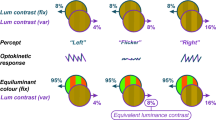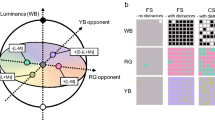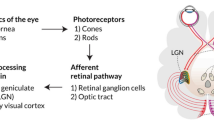Abstract
IN the perception of brightness the responses from all three classes of cone in the human eye are pooled. Evidence from recent electrophysiological measurements1, however, indicates that the contrast detected by a particular colour channel is assessed independently of the summation. Specifically, the existence of a red sensitive channel in which this occurred was demonstrated.
This is a preview of subscription content, access via your institution
Access options
Subscribe to this journal
Receive 51 print issues and online access
$199.00 per year
only $3.90 per issue
Buy this article
- Purchase on SpringerLink
- Instant access to full article PDF
Prices may be subject to local taxes which are calculated during checkout
Similar content being viewed by others
References
Regan, D., Nature, 250, 437–439 (1974).
Ellis, B., Burrell, G. J., Wharf, J. H., Hawkins, T. D. F., and Peters, D. V., Proc. Soc. Inf. Display, 15, 150–160 (1974).
Ellis, B., Burrell, G. J., Wharf, J. H., and Hawkins, T. D. F., Soc. Inform. Displ. Symp. Digest, 106–107 (San Diego, 1974).
Wald, G., Science, 145, 1007–1017 (1964).
Rushton, W. A. H., Powell, D. S., and White, K. D., Vision Res., 13, 2003–2015 (1973).
Stiles, W. S., Proc. natn. Acad. Sci. U.S.A., 45, 100–114 (1959).
Tyte, R. N., Wharf, J. H., and Ellis, B., Soc. Inform. Displ. Symp. Digest (Washington, in the press).
Author information
Authors and Affiliations
Rights and permissions
About this article
Cite this article
ELLIS, B., BURRELL, G., WHARF, J. et al. Independence of channels in colour contrast perception. Nature 254, 691–692 (1975). https://doi.org/10.1038/254691a0
Received:
Revised:
Issue date:
DOI: https://doi.org/10.1038/254691a0



